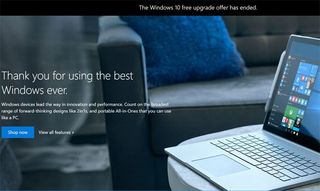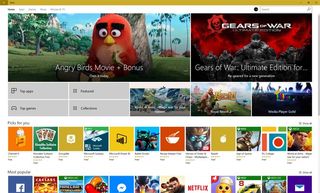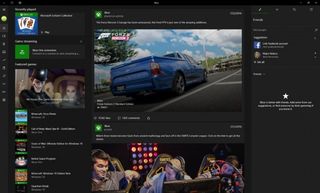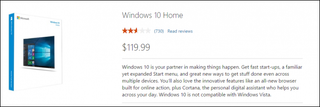Microsoft Foolish to End Free Windows 10 Upgrade Program
It's over. Microsoft's year-long free Windows 10 upgrade offer ended on Saturday and consumers who want to move on from Windows 7 or 8 will have to either pay $119 for the new OS or, more likely, stay put. Microsoft is certainly well within its rights to end the program, but At first glance, Microsoft's free upgrade program seems like an act of generosity. After all, we've been conditioned to believe that Windows should cost money, because all previous Windows upgrades had some kind of cost. I'm old enough to remember paying $100 to buy a Windows 95 disc from Compusa at midnight on launch day, because I was excited about being able to have filenames that were longer than 8 characters.

However, in 2016, every other major operating system vendor gives its software away for free, both to users who want an upgrade and to manufacturers who want to install it on their PCs. Apple comes out with new versions of both its desktop and mobile operating systems every year, but since 2013, all of them have been free. Google not only provides free Android and Chrome OS updates to users, but also offers these platforms to phone, tablet and laptop vendors for free. Ubuntu and other forms of Linux have always been free.
Microsoft didn't choose to give its operating system away out of a sense of generosity. The company needs users on Windows 10.
It undoubtedly costs Apple and Google millions of dollars to keep developing their platforms, but the companies realize that they benefit a great deal, just from having people use their ecosystem. Both Android and Chrome OS promote Google services like Gmail, Docs and Google Search, all of which are loaded with ads, the company's main source of revenue. Apple makes a bank on sales from its app store (and its devices), which can't exist without its operating systems.

Just like Apple and Google, Microsoft didn't choose to give its operating system away out of a sense of charity or generosity. The company needs users on Windows 10 in order to increase sales from its own app store. The store doesn't even run on Windows 7 (an older version appeared on 8) so every user who sticks with the old OS is a lost sales opportunity.
With Windows 10, Microsoft introduced a new class of programs called "Universal Apps." This new type of software adapts its interface based on whether you're using a touch screen or a keyboard and mouse, but it doesn't work at all on Windows 7 or 8. If you're a developer and you know that only some of your potential customers are on Windows 10, why would you make your app a Universal App?
MORE: You Can Still Get Windows 10 for Free, If You Lie
If you're on Windows 10, you can buy a subscription to the company's Groove Music streaming service or you can buy videos from the built-in store. Since Windows 10 has great Xbox integration features, users of the OS are probably more likely to buy and stick with Microsoft's console rather than getting a Playstation or Wii.
Stay in the know with Laptop Mag
Get our in-depth reviews, helpful tips, great deals, and the biggest news stories delivered to your inbox.

Microsoft also benefits a great deal from all the data it collects from Windows 10 users. Though the data is anonymized, the company can use it to spot trends and even to serve you targeted ads. There's no doubt that this data is worth money.
In fact, it's pretty clear that every Windows 10 user has incredible value to Microsoft. Somewhere in the Redmond halls of power, there's probably a secret spreadsheet where the marketing department has figured out exactly how much one Windows 10 user is worth on average.
No one is going to pay $119 to upgrade to Windows 10 today, if they weren't willing to do it for free in the past.
It's fair to say that, after 12 months, most consumers have had plenty of time to upgrade to Windows 10. However, the upgrade process is not always as easy as it should be. Some folks may have tried, failed and given up for a while. It took my wife six months and over two dozen failed attempts (with awkward error messages like "something happened") before she finally decided to erase her hard drive, install Windows 7 from scratch and then run the Windows 10 upgrade. My mother's Windows 7 laptop failed over half a dozen times, reporting that it didn't have enough space for Windows 10, even though it had 140GB free.
Other people may have chosen not to upgrade to Windows 10 during the first year, because they haven't seen a compelling reason to change. They're probably looking at Windows 7 and saying "if it ain't broke, I'm not going to fix it." But these users may change their minds and want to upgrade in the future when they get to experience Windows 10 more closely or when Microsoft adds new features they just can't resist.
Perhaps a family with a Windows 7 PC buys a cheap laptop for the kids and it has Windows 10 on it. All of a sudden, they understand the benefits of the new OS like they never have before and they want to run it on their main computer, but it's too late to upgrade for free.
So why is Microsoft ending its free upgrade program? Revenue from OS sales can't possibly be the reason. I promise you that no one is going to pay $119 to upgrade to Windows 10 today, if they weren't willing to do it for free in the past.

In May, Computerworld's Gregg Keizer argued that Microsoft has to end the upgrade program, because OEMs want to use the OS as a selling point for new computers. Again, if someone wasn't willing to upgrade to Windows 10 for free and isn't willing to spend $119 for a license, why on earth would they pay $500 for a new computer, just to get it? If the PC vendors can't make compelling enough hardware to entice consumers, they can't rely on the promise of preloaded Windows 10 to save them.
By standing on principle and ending the program after exactly a year, Microsoft is hurting itself more than its customers.
Keizer also argues that Microsoft has to end its free upgrade program because Enterprise customers are annoyed that they have to pay to move to Windows 10 while consumers get it for free. But big businesses pay these fees because they are getting added security and networking features. Also, wouldn't these customers have already been annoyed during the first year of upgrades? That ship has sailed.

The strongest reason for Microsoft to end the free upgrade program is to live up to its word. The company announced that users would have a limited time to upgrade and keeping to a firm deadline puts pressure on them to make the move to Windows 10. If Microsoft suddenly extended the deadline for Windows 10, what would that mean for next time?
However, by standing on principle and ending the program after exactly a year, Microsoft is hurting itself more than its customers. Yes, 300 million devices are running Windows 10 but a lot more people are still on Windows 7. According to Net Applications, only 19.1 percent of devices run Windows 10 compared to 49.1 percent that run Windows 7 and 10.5 percent that run Windows 8 or 8.1. That's a lot of people who won't be buying apps from the Windows Store, won't be subscribing to additional Microsoft services and won't be sharing their telemetry data with Microsoft.
Windows 10 Basics
- 7 Settings to Change Right Away
- Windows 10 Keyboard Shortcuts to Save You Clicks
- 5 Ways to Take Screenshots
- Change Your Password in Windows 10
- Uninstall Programs in Windows 10
- Enable or Disable Tablet Mode
- Add a User (Child or Adult)
- Change the Screen Resolution
- Sync Your Settings Across Devices
- Sync iPhone with Windows 10
- Control Windows 10 with Your Voice
- Upgrade to Windows 10 From Windows 7 or 8
- Eliminate Blue Light With Night Light
- Create a New Folder
- Get to the Desktop in Windows 10
- Add a Printer
- All Windows 10 Tips
- Set Alarms
